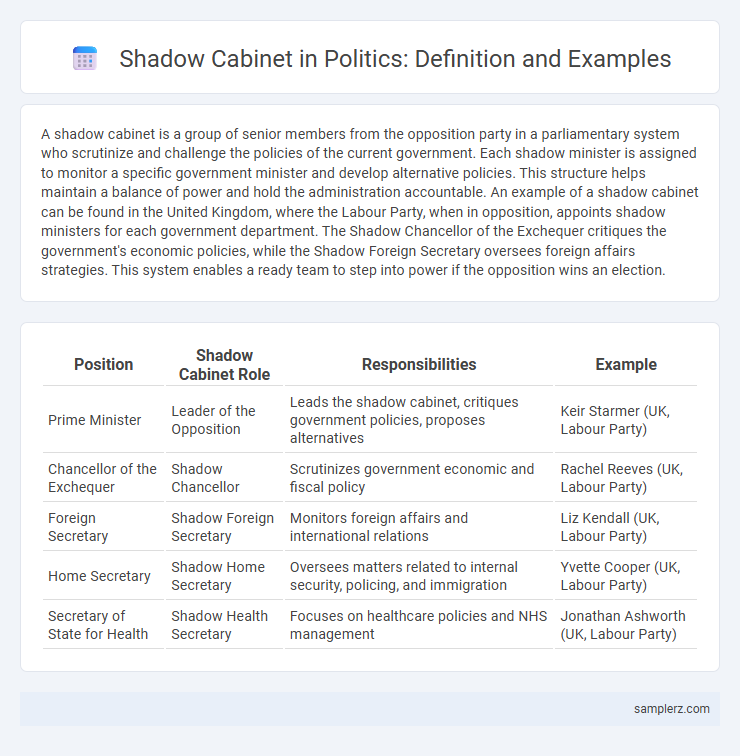A shadow cabinet is a group of senior members from the opposition party in a parliamentary system who scrutinize and challenge the policies of the current government. Each shadow minister is assigned to monitor a specific government minister and develop alternative policies. This structure helps maintain a balance of power and hold the administration accountable. An example of a shadow cabinet can be found in the United Kingdom, where the Labour Party, when in opposition, appoints shadow ministers for each government department. The Shadow Chancellor of the Exchequer critiques the government's economic policies, while the Shadow Foreign Secretary oversees foreign affairs strategies. This system enables a ready team to step into power if the opposition wins an election.
Table of Comparison
| Position | Shadow Cabinet Role | Responsibilities | Example |
|---|---|---|---|
| Prime Minister | Leader of the Opposition | Leads the shadow cabinet, critiques government policies, proposes alternatives | Keir Starmer (UK, Labour Party) |
| Chancellor of the Exchequer | Shadow Chancellor | Scrutinizes government economic and fiscal policy | Rachel Reeves (UK, Labour Party) |
| Foreign Secretary | Shadow Foreign Secretary | Monitors foreign affairs and international relations | Liz Kendall (UK, Labour Party) |
| Home Secretary | Shadow Home Secretary | Oversees matters related to internal security, policing, and immigration | Yvette Cooper (UK, Labour Party) |
| Secretary of State for Health | Shadow Health Secretary | Focuses on healthcare policies and NHS management | Jonathan Ashworth (UK, Labour Party) |
Understanding the Shadow Cabinet: A Political Overview
The Shadow Cabinet serves as an opposition counterpart to the official Cabinet, comprising senior members of the main opposition party tasked with scrutinizing government policies and presenting alternative solutions. Each Shadow Minister shadows a specific Cabinet Minister, holding them accountable and preparing to assume office if their party wins the next election. This structure enhances parliamentary democracy by promoting transparency, debate, and readiness within the political system.
Historical Origins of the Shadow Cabinet
The concept of the shadow cabinet originated in the United Kingdom during the 19th century as an institutionalized opposition mechanism within the parliamentary system. It formalizes the role of senior members of the opposition party in scrutinizing government policies and presenting alternative solutions, thereby enhancing democratic accountability. This framework has influenced parliamentary democracies worldwide, embedding the practice of structured political oversight in executive governance.
Structure and Roles within a Shadow Cabinet
A shadow cabinet mirrors the official government cabinet, consisting of senior members from the opposition assigned specific portfolios to scrutinize and challenge their counterparts' policies. Each shadow minister specializes in various sectors such as finance, health, or foreign affairs, providing alternative policy solutions and holding the government accountable through parliamentary debates and media engagement. This structure enables the opposition to present a ready team for governance, ensuring effective oversight and political accountability.
Key Functions of Shadow Cabinet Members
Shadow cabinet members perform vital roles such as scrutinizing government policies, proposing alternative solutions, and holding ministers accountable through robust debate. They serve as the official opposition's spokespersons for specific departments, ensuring continuous oversight and readiness to assume power if elected. Key functions include policy development, parliamentary questioning, and public communication to influence political discourse.
Notable Examples of Shadow Cabinets Globally
The United Kingdom's Shadow Cabinet is one of the most prominent examples, with the Leader of the Opposition appointing senior party members to scrutinize government ministers and propose alternative policies. In Australia, the Shadow Cabinet operates similarly, with key figures holding portfolios that correspond directly to government ministers, ensuring robust parliamentary debate. Canada's Shadow Cabinet plays a critical role within its Westminster-style system, where opposition members are assigned to shadow specific ministries, enhancing accountability and public policy discourse.
Shadow Cabinet vs. Official Government Cabinet
The Shadow Cabinet in parliamentary systems consists of senior opposition members who scrutinize and challenge policies proposed by the Official Government Cabinet, holding them accountable for their decisions. Each Shadow Cabinet member typically mirrors a government minister's portfolio, allowing for direct criticism and proposing alternative policies. This structure strengthens democratic oversight by providing a prepared opposition team ready to assume power if elected.
Impact of the Shadow Cabinet on Legislative Processes
The shadow cabinet significantly influences legislative processes by scrutinizing government policies and proposing alternative solutions, ensuring robust parliamentary debates. Their detailed analysis and public accountability efforts promote transparency and can sway public opinion, driving legislative priorities. By holding the ruling cabinet accountable, the shadow cabinet enhances democratic checks and balances within the political system.
Famous Politicians Who Served as Shadow Ministers
Famous politicians who served as shadow ministers include Margaret Thatcher, who was the Shadow Secretary of State for Education and Science before becoming the first female Prime Minister of the United Kingdom. Tony Blair held the position of Shadow Home Secretary, shaping key policies that informed his later tenure as Prime Minister. Another notable figure is Keir Starmer, who served as Shadow Secretary of State for Exiting the European Union before leading the Labour Party.
Criticisms and Controversies Surrounding Shadow Cabinets
Shadow cabinets often face criticisms for lacking accountability since their members hold no official power while scrutinizing government policies. Controversies arise when shadow ministers engage in partisan tactics or fail to present coherent alternative policies, leading to public skepticism about their effectiveness. The symbolic nature of shadow cabinets sometimes sparks debate over whether they contribute to democratic transparency or merely serve political posturing.
How Shadow Cabinets Shape Political Opposition Strategies
Shadow Cabinets play a crucial role in shaping political opposition strategies by providing structured scrutiny of government policies and proposing alternative solutions. In the UK, the Labour Party's Shadow Cabinet mirrors the official Cabinet, enabling targeted challenges and coherent policy development. This organized opposition enhances democratic accountability and prepares parties for potential governance roles.

example of shadow in cabinet Infographic
 samplerz.com
samplerz.com